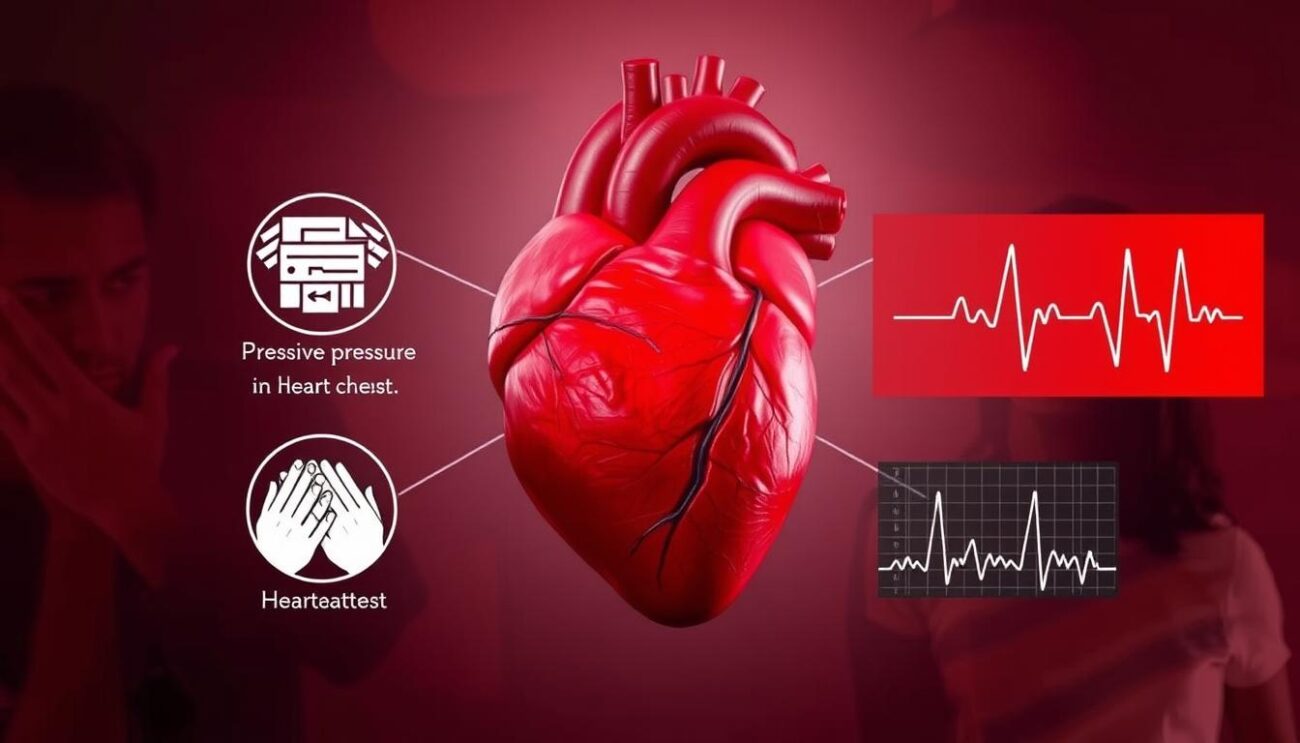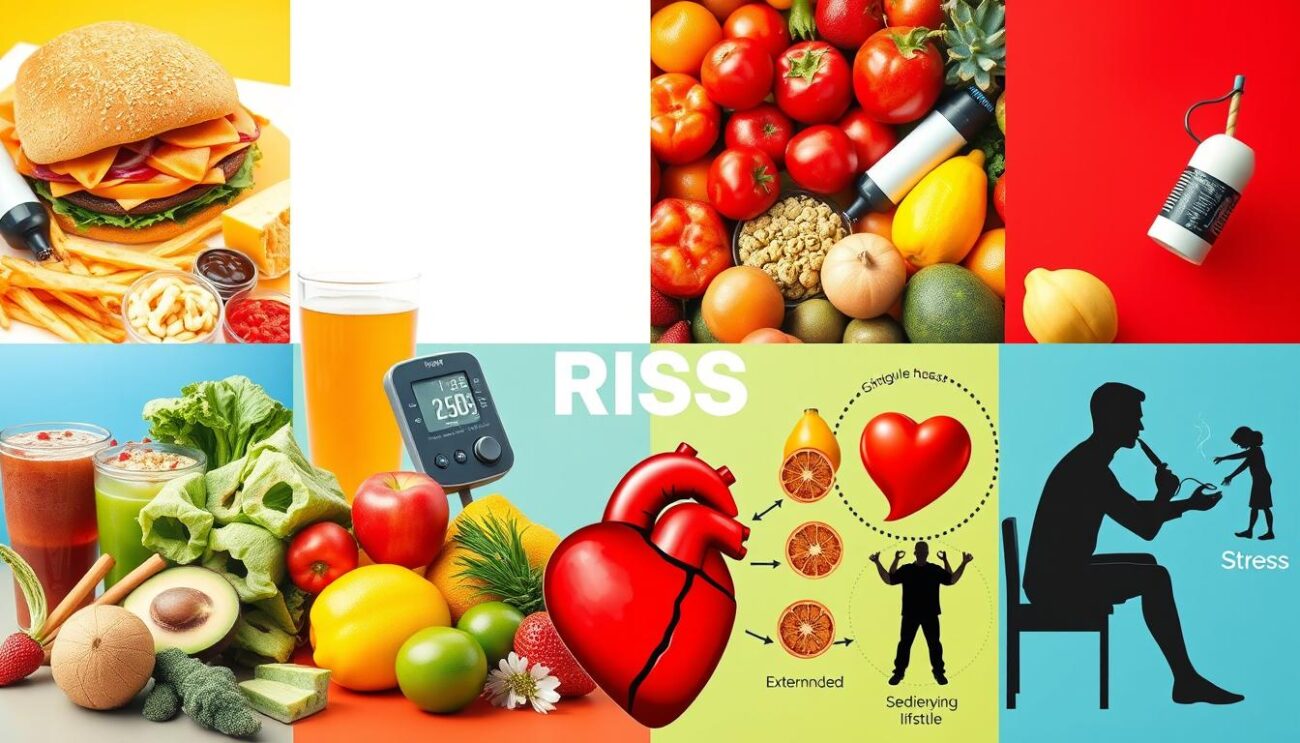Do you know the signs of a heart attack? Heart disease is the top killer in the U.S. It’s key to know the warning signs and act fast. Can you spot the subtle signs of a serious emergency?
The American Heart Association says common symptoms include chest pain lasting more than a few minutes. You might also feel pain in your arms, back, neck, jaw, or stomach. Shortness of breath is another sign.
Other symptoms include cold sweat, nausea, or feeling lightheaded. Men and women can have different symptoms. Women might feel short of breath, nauseous, or experience back or jaw pain. It’s vital to spot these signs and call 911 fast. Every minute counts for lifesaving treatment.
Key Takeaways
- Heart disease is the leading cause of death for both men and women in the U.S.
- Chest discomfort, upper body pain, and shortness of breath are common heart attack symptoms.
- Women may experience less typical symptoms like nausea, back/jaw pain, and fatigue.
- Recognizing the warning signs and calling 911 quickly can be lifesaving.
- Factors like age, high blood pressure, and obesity increase heart attack risk.
Recognizing the Symptoms
Chest discomfort is a common warning sign of a heart attack. It can feel like pressure, squeezing, or pain in the chest. This feeling lasts more than a few minutes or comes and goes.
The pain can spread to other areas like the arms, back, neck, jaw, or stomach. This is a key warning sign that should not be ignored.
Chest Discomfort
The chest discomfort of a heart attack feels like pressure or pain in the center. It may come and go or stay for more than a few minutes. Recognizing this chest pain, chest pressure, or chest tightness is crucial.
Discomfort in Upper Body
Pain can also spread to the arms, back, neck, jaw, or stomach. This arm pain, shoulder pain, back pain, neck pain, or jaw pain is a big indicator of a heart attack.
Knowing these symptoms and getting medical help fast is key. Quick treatment can save the heart muscle and improve outcomes.
“Chest discomfort is often the first and most obvious sign of a heart attack, but it’s important to be aware of other potential symptoms as well.”
Shortness of Breath
Shortness of breath, or dyspnea, is a common symptom of a heart attack. It makes you feel like you can’t catch your breath, even when you’re sitting still. This is a sign that your heart might not be pumping blood well.
Feeling like you’re gasping for air or breathing heavily are signs of shortness of breath. It can happen with or without chest pain. So, it’s key to notice any changes in how you breathe.
If you’re feeling short of breath, get medical help right away. Ignoring this sign can be risky. It might mean you have a serious heart problem that needs quick treatment.
Acting fast when you see heart attack signs is crucial. It can help you recover better. If you or someone you know is having trouble breathing or chest pain, call for emergency help.
Other Warning Signs
Chest discomfort and shortness of breath are common heart attack symptoms. But, there are other warning signs to watch out for. Feeling a cold sweat, nausea or vomiting, or unexplained fatigue or weakness can signal a heart attack, especially in women.
Back pain is also a warning sign, though less common. It can happen alongside or instead of chest pain, especially if you’re also short of breath.
Knowing all the heart attack warning signs is key. Recognizing them early can save lives. If you see any of these symptoms, call for help right away.
| Symptom | Prevalence | Significance |
|---|---|---|
| Cold Sweat | Relatively Common | Can be an early indicator of a heart attack, especially in women. |
| Nausea/Vomiting | Relatively Common | Can be a sign of a heart attack, particularly in women. |
| Unexplained Fatigue | Relatively Common | Can be an early symptom of a heart attack, especially in women. |
| Back Pain | Less Common | Can be a warning sign of a heart attack, especially when accompanied by chest discomfort or shortness of breath. |
“Women are more likely than men to have heart attack symptoms unrelated to chest pain, such as neck, jaw, shoulder, upper back, or upper belly discomfort.”
Heart Attack Warning Signs
Knowing the heart attack symptoms and warning signs is key to saving lives. The main signs include chest discomfort, upper body pain, shortness of breath, and other symptoms like nausea, cold sweat, and fatigue.
Chest discomfort is a common heart attack symptom. It can feel like pressure, squeezing, or pain in the chest. This discomfort may come and go or stay the same.
Discomfort in the arms, back, neck, jaw, or stomach can also signal a heart attack. This discomfort may happen with or without chest pain.
Shortness of breath is another heart attack symptom. It can happen with or without chest pain.
Other warning signs include:
- Nausea or vomiting
- Cold sweat
- Fatigue
- Lightheadedness or dizziness
It’s vital to recognize these signs and call 911 right away. Quick action is crucial for survival and to prevent heart damage. Don’t ignore these signs, as they can mean a serious emergency.
“Too many New Zealanders die or live with permanent disability due to a lack of awareness of heart attack warning signs and delays in seeking medical help.”

Knowing the heart attack symptoms and warning signs helps you act fast. Remember, every second counts in a heart attack. So, call 911 without hesitation if you or someone you know shows these signs.
Gender Differences
Both men and women often feel chest pain or discomfort during a heart attack. But women may notice other signs too. Women’s heart attack symptoms can include shortness of breath, nausea, and back or jaw pain. These signs might be less obvious and harder to spot.
Because of these differences, it’s tougher for women to know they’re having a heart attack. It’s important for them to understand the various heart attack symptoms in women. Quick action and treatment are key to avoiding serious problems.
Here are some main differences in heart attack symptoms between men and women:
- Women are more likely to experience nausea, vomiting, and back or jaw pain during a heart attack.
- Women tend to have a combination of less-recognized symptoms such as fatigue, dizziness, and indigestion.
- Women are more likely to attribute heart attack symptoms to non-life-threatening conditions like the flu or stress.
- Women are more likely to delay seeking medical help during a heart attack, which can lead to serious consequences.
Knowing the unique women’s heart attack symptoms and acting fast can save lives. It’s crucial for women to seek medical help right away if they notice any of these signs.
When to Call 911
Minutes are crucial when it comes to a heart attack. If you or someone you know shows major heart attack warning signs, call 911 or your local emergency number right away. Don’t wait to see if the symptoms go away.
Calling an ambulance is the fastest way to get help. It can be the difference between life and death in a heart attack emergency. The sooner you call 911 for a heart attack, the better your chances of survival and recovery.
- Chest discomfort or pain that lasts more than a few minutes or comes and goes
- Discomfort or pain in the upper body, including the arms, back, neck, jaw, or stomach
- Shortness of breath, with or without chest discomfort
- Other warning signs like cold sweats, nausea, or lightheadedness
Recognizing symptoms and acting quickly is key. Don’t hesitate to call for help if you suspect a heart attack. Your quick action could save a life.
“Every minute counts when it comes to a heart attack. Calling 911 immediately can make the difference between life and death.”
Remember, the sooner you call 911 for a heart attack, the better your chances of survival and recovery. Don’t wait, act fast and call for emergency medical assistance right away.
Causes and Risk Factors
Heart attacks often happen because of coronary artery disease. This is when fatty deposits, called plaque, build up in heart arteries. This buildup can block blood flow, leading to a heart attack. Other causes include coronary artery spasm, infections like COVID-19, and artery wall tears.
Big risk factors for heart attacks include being older, smoking, and having high blood pressure or cholesterol. Diabetes, obesity, not exercising, eating poorly, and a family history of heart disease also increase risk. Lifestyle choices like smoking, drinking too much, and not exercising can also raise risk.
The risk of having a heart attack goes up with age. It starts at 45 for men and at 50 or menopause for women. Health issues like high blood pressure, bad eating, diabetes, and obesity can also harm the heart.
Getting quick treatment is key to surviving a heart attack. It’s important to recognize symptoms fast and call 911. This helps get medical help right away.
Key Risk Factors
- Older age
- Smoking
- High blood pressure
- High cholesterol
- Diabetes
- Obesity
- Lack of exercise
- Unhealthy diet
- Family history of early heart disease
| Cause | Percentage |
|---|---|
| Coronary Artery Disease | Primary Cause |
| Coronary Artery Spasm | Secondary Cause |
| Infections (e.g., COVID-19) | Potential Cause |
| Artery Wall Tear | Potential Cause |
According to the CDC, a heart attack occurs every 40 seconds in the United States, with more than a million Americans experiencing one each year.
Conclusion
Knowing the signs of a heart attack and getting help fast can save lives. Some heart attacks come without warning, but others give clues like chest pain and shortness of breath. If you notice these signs, call 911 right away.
Working to lower your risk factors is also crucial. Eating well, exercising, and managing health issues like high blood pressure can help prevent heart attacks. Making heart health a priority is essential for everyone.
Learning about heart attack signs and taking steps to prevent them can protect you and your family. Awareness, prevention, and quick action are key to beating heart attacks. They help keep our hearts healthy and strong.







